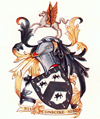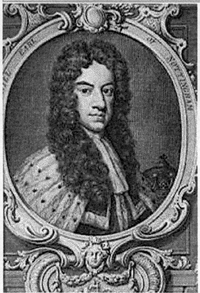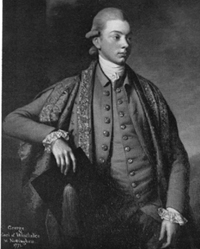
(click here to see a larger image of the family Coat of Arms)

He was educated at Westminster School. In 1635 he became a gentleman commoner at Christ Church, Oxford. On the sudden death of his father, also Heneage Finch, he left; before taking his degree. He did, however, enter the Inner Temple where he soon became a proficient student, and read for the Bar. He was called to the Bar in 1645. He, apparently, took no part in the troubles of the Civil War concentrating instead on building up a lucrative private practise.
At the Restoration, in 1660, he was returned as Member of Parliament for the City of Canterbury. On 6 June 1660 the King again showed his favours by making him Solicitor General and, the following day, he was created Baronet of Ravenstone, Buckinghamshire. In April 1661 he was elected to Charles II second Parliament for the University of Oxford.
On the death of Sir Jeffrey Palmer, Sir Heneage Finch was made Attorney General on 10 May 1670. Soon afterwards he became Councillor to Queen Catherine. From 1673 - 1676 he was Chamberlain of Chester. On 9 November 1673 his ambitious hopes were realised when he received the Great Seal. He was created Baron Finch of Daventry, from the Manor he owned in Northamptonshire, on 10 January 1674.
He reached the summit of his profession and became Lord Chancellor on 19 December 1674. The purchase of the Manor of Milton, from Henry Stafford and Anne Dawes, widow, was made in 1677. This was a joint purchase with his eldest son, Daniel.
For 9 years he held the Great Seal and presided over the Court of Chancery. On 12 May 1681, as a further reward for his services to the crown, he was created Earl of Nottingham.
In 1646 he married Elizabeth Harvey, daughter of Daniel Harvey a London merchant. Their eldest son, Daniel was born in 1647, and became second Earl. Heneage, the second son was Solicitor General and created Earl of Aylesford. The fifth son Edward (1664 - 1738) was a composer.
He died 18 December 1682, in London, and was buried at Ravenstone, Buckinghamshire.

He was elected to Parliament for Great Bedwin, Wiltshire 10 February 1672 although he did not take his seat. He became a Privy Councillor 4 February 1679 and was made Lord of the Admiralty 22 April 1679. The Borough of Lichfield returned him to Parliament on 7 August 1679.
First Lord of the Admiralty from 19 February 1680 - 22 May 1684. He was elected Member of Parliament by both Lichfield and Newtown, in March 1681, but was called instead to the House of Lords by his father's death 18 December 1682.
He married firstly Lady Essex Riche, second daughter and co-heiress of Robert, Earl of Warwick, and secondly, Anne, daughter of Christopher, Viscount Hatton and Cecilie

In 1804 he became Groom of the Stole to George III, and in 1822 accompanied George IV on his tour of Scotland.
When he died in 1826, unmarried, he was succeeded in his titles by his cousin George William Finch-Hatton. His house at Burley on the Hill, and at least the titles of Lord of Milton Keynes, Burley and Ravenstone manors, were inherited by his illegitimate son, George Finch, who was born in 1794.
1870 - 1907 FINCH,George Henry (1835 - 1907) - Son of George Finch and his second wife Louisa. Born 20 February 1835. Educated at New College, Oxford. He married Emily Eglantine, daughter of John Balfour of Balbernie, Fife in 1861. They had a son, Alan George Finch, born in 1863 and 2 daughters Magdalen and Gwendoline. Emily died in 1865. Shortly afterwards he became Conservative member of Parliament for Rutland, in 1867, which he remained for 34 years. He married again in 1871, Edith, daughter of A. Montgomery, Commissioner of Inland Revenue. Their children included Wilfred Henry Montgomery Finch. Altogether his marriages produced a total of 10 children, 3 sons and 7 daughters. Also a Justice of the Peace and a Member of the Carlton Club. Died 22 May 1907.
1907 - 1914 FINCH, Alan George (1863 - 1914) - Son of George Henry Finch, was sent to fight under General Carrington in Matabeleland in1893. In 1888 Rhodes secured an agreement with Lobengbula to take over and colonise Mashonaland, the territory east of Matabeleland. In 1890 this land was under the governorship of Dr. Jameson a friend of Rhodes. The Matabele continued to raid their neighbours and make incursions over the border and finally took to fighting and killing the Mashonaland Police. Eventually in 1893 Jameson organised a counter - offensive with the white settlers in Mashonaland which resulted in the capture of Logenbula's head kraal at Buluwayo. Logenbula fled northwards to contact his troops and was not back in time to repel the British. He died in the bush a fugitive two months later. Major Wilson, with thirty-four mounted men form Major Forbes' column, had pursued Logenbula in an attempt at capture. They were cut off by a rising river and a fresh army of warriors. The story of their last stand has become an epic in the history of the country and their bones are laid near those of Rhodes himself at "The World's View" in the Matapos. Chief Nityana who led the attack against Major Wilson described Wilson's end:
"The Induna was bewitched. We shot him with six rides and he still fought. A wounded man passed a new gun to him all the time. but we killed him at alst and the wounded men who could not fight just put their hands over their eyes while we ran assegais into them. Ah I they do not like the Mashonas. They never cry or groan. They are Men"
1914 - 1939 FINCH, Wilfred Henry Montgomery (1883 - 1939) - Son of George Henry Finch and his second wife, Edith. Educated at Charterhouse. He appears to have been in the Armed Forces, reaching the rank of Lieutenant, retired. Shortly prior to his death he was a temporary Lieutenant in the Royal Engineers. Lord of the Manors of Burley, Oakham, Ravenstone and Milton Keynes. Club - Bath. He never married, and upon his death his titles and property passed to Colonel James Robert Hanbury.
1939 - HANBURY, Colonel James Robert - Great nephew of George Henry Finch. His grandfather, Colonel Evan Hanbury married Gwendoline.